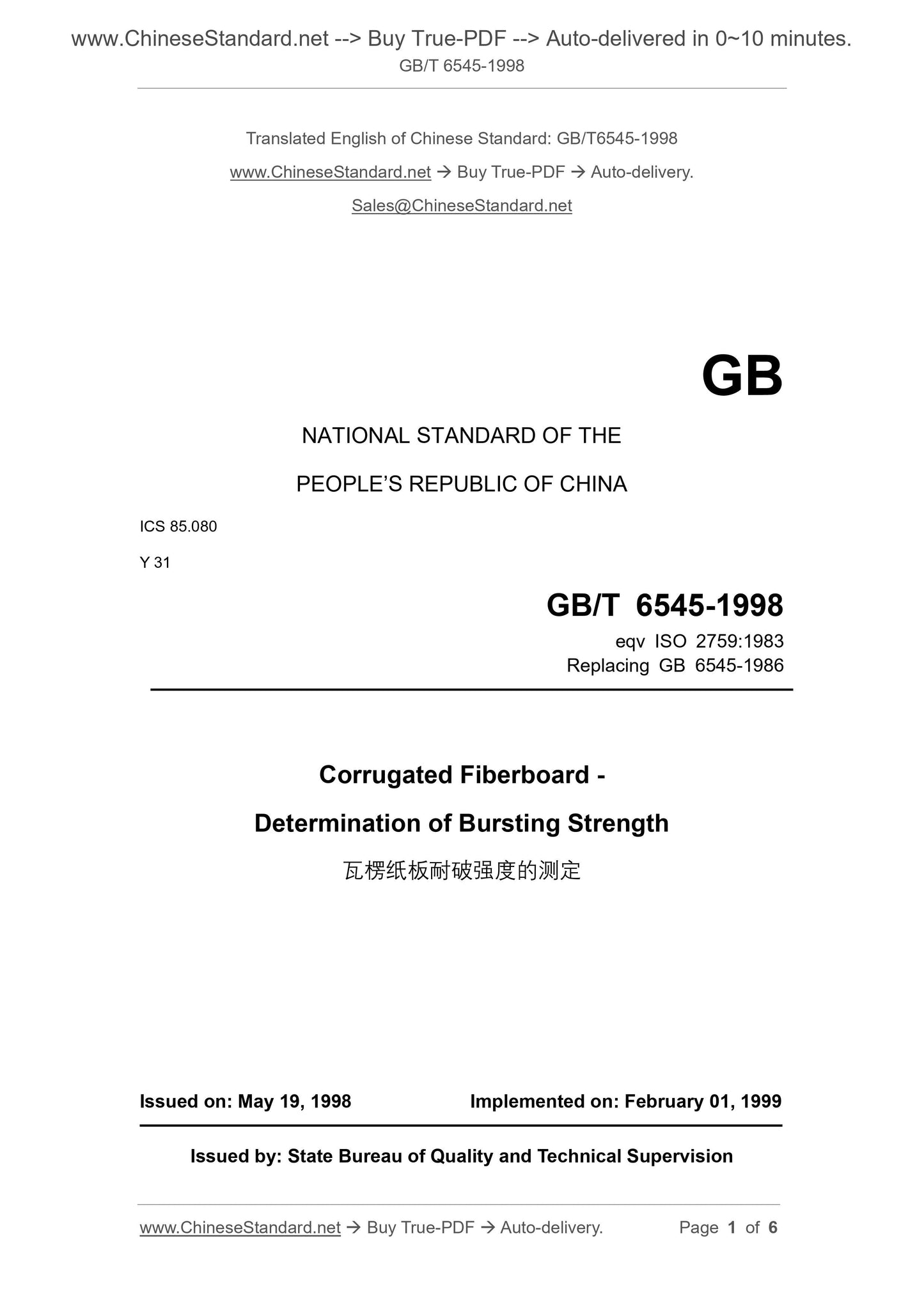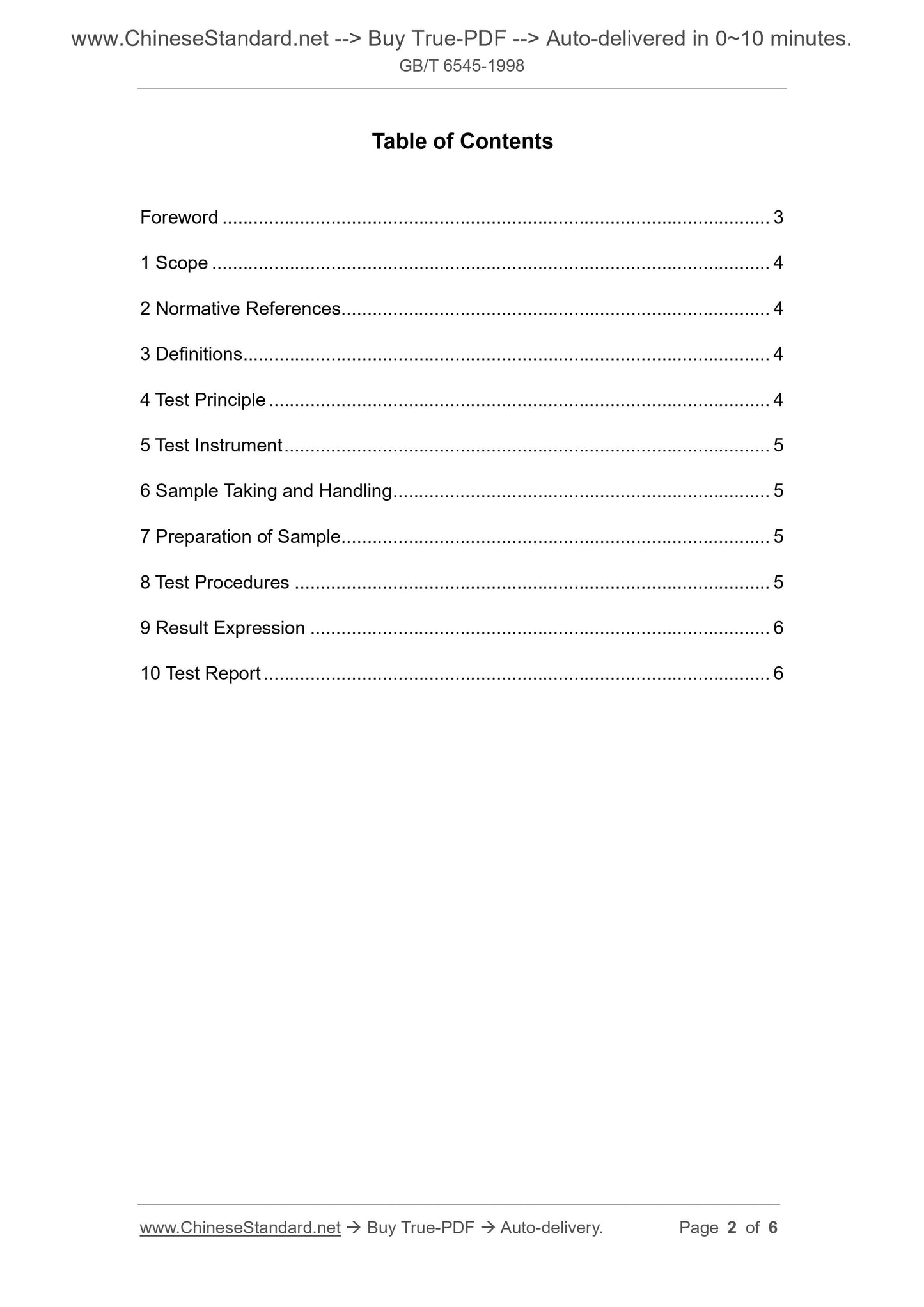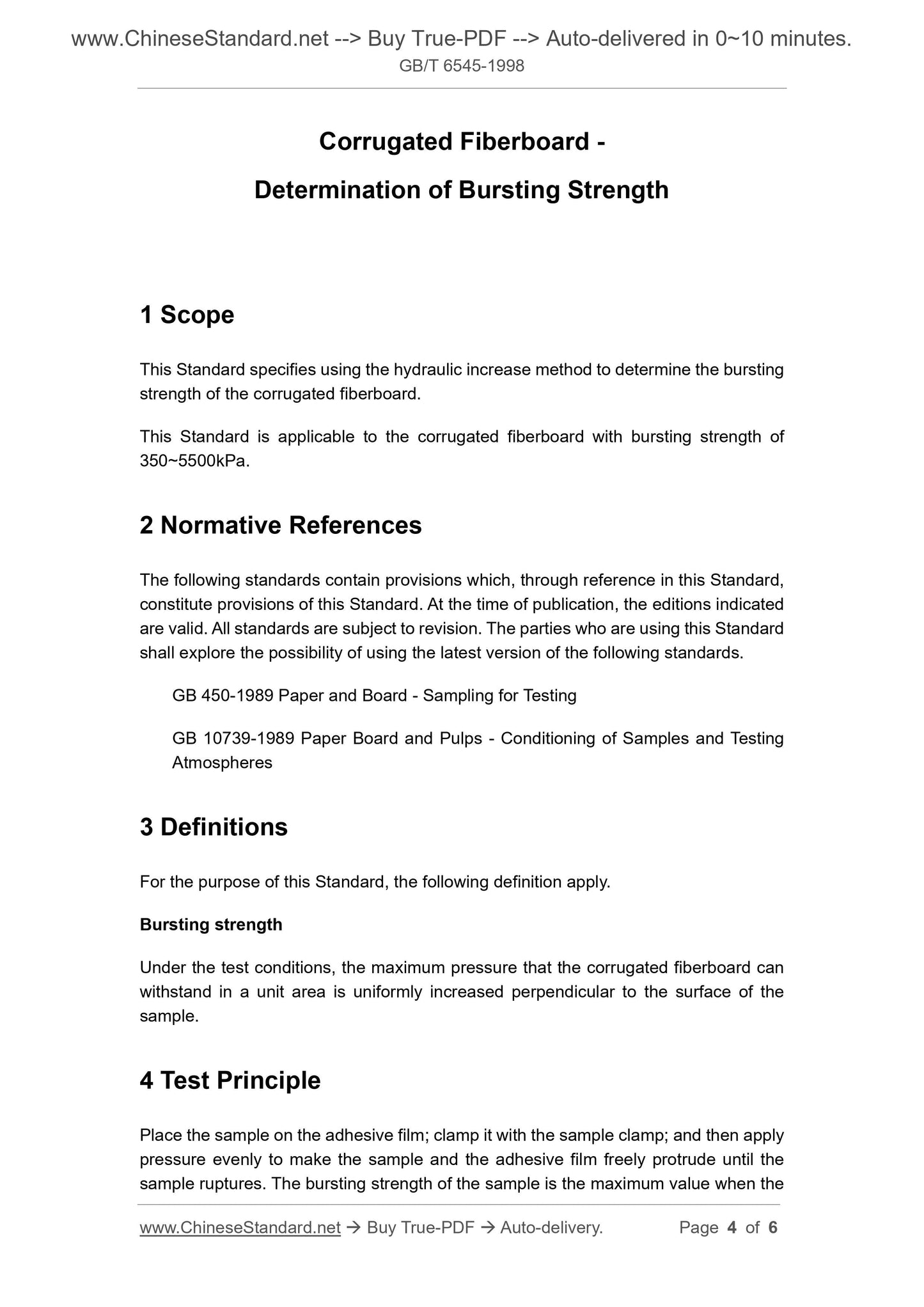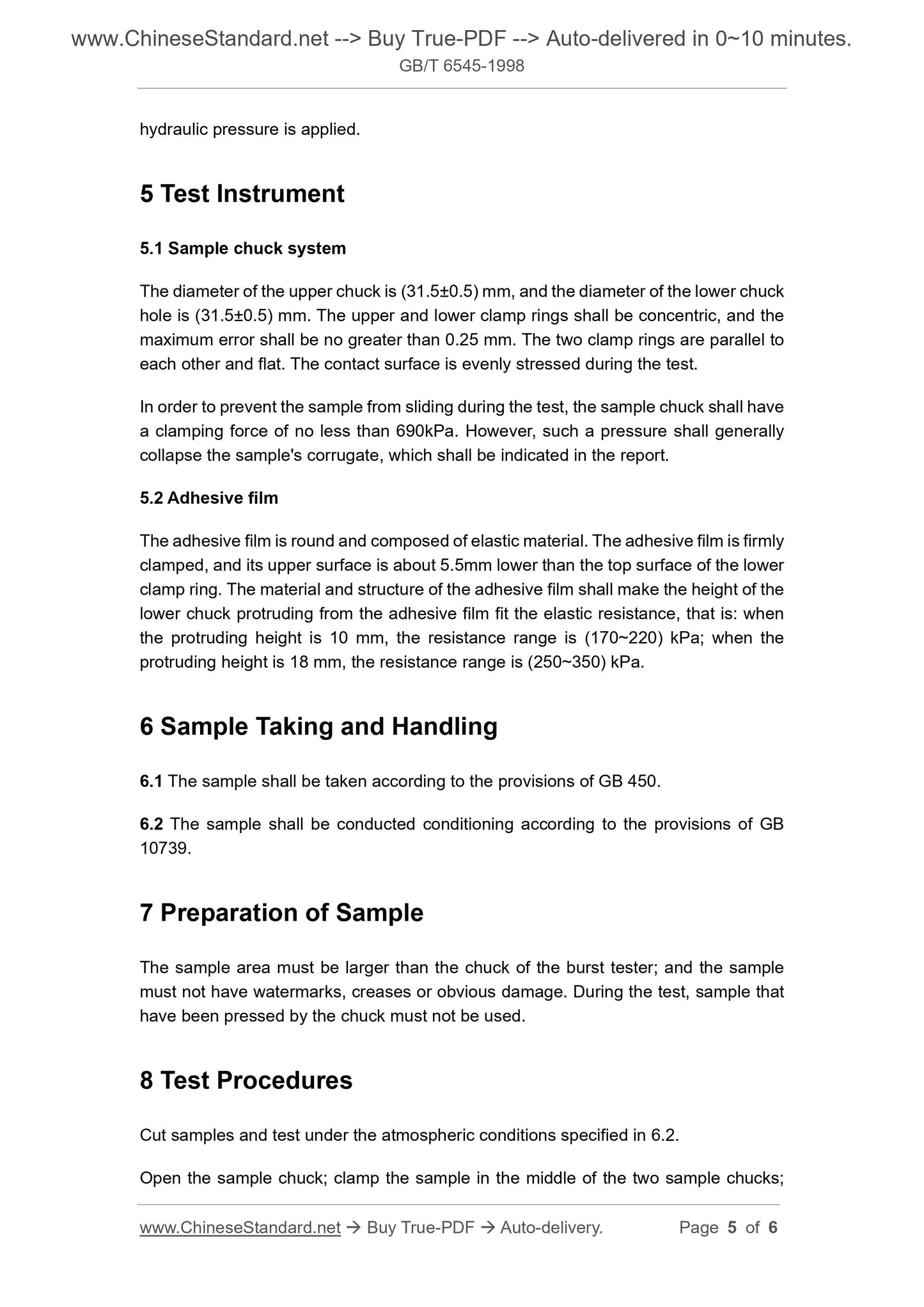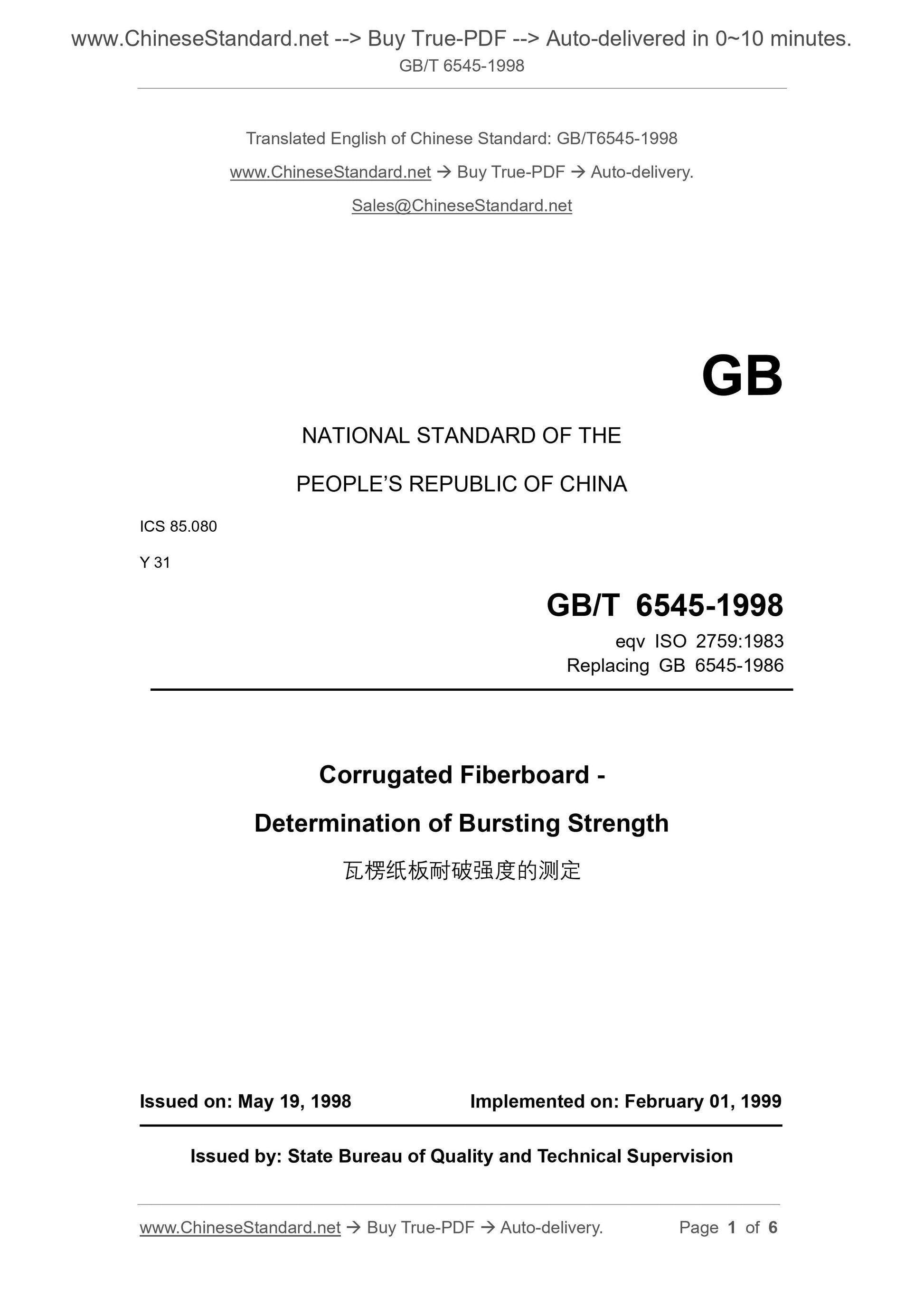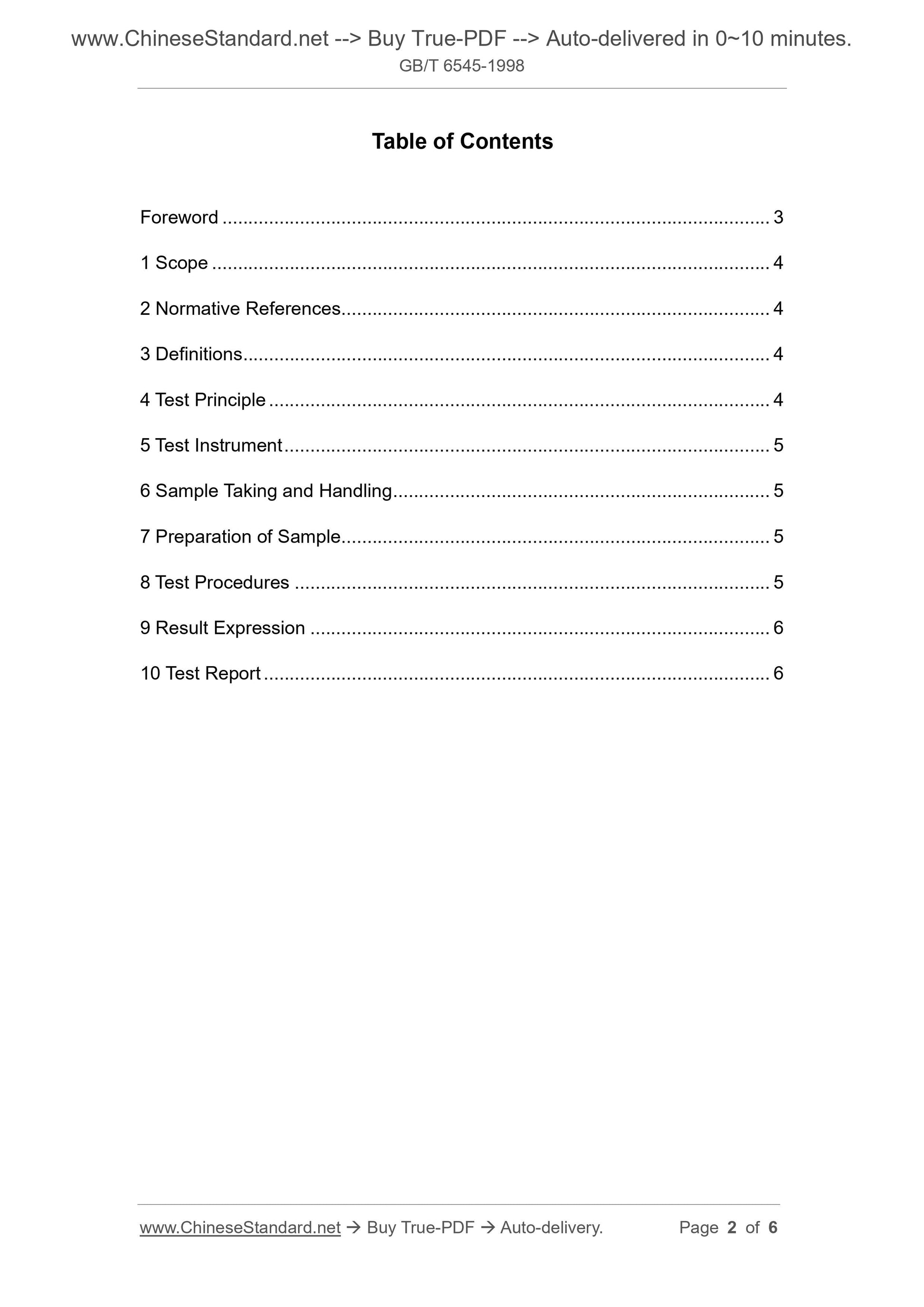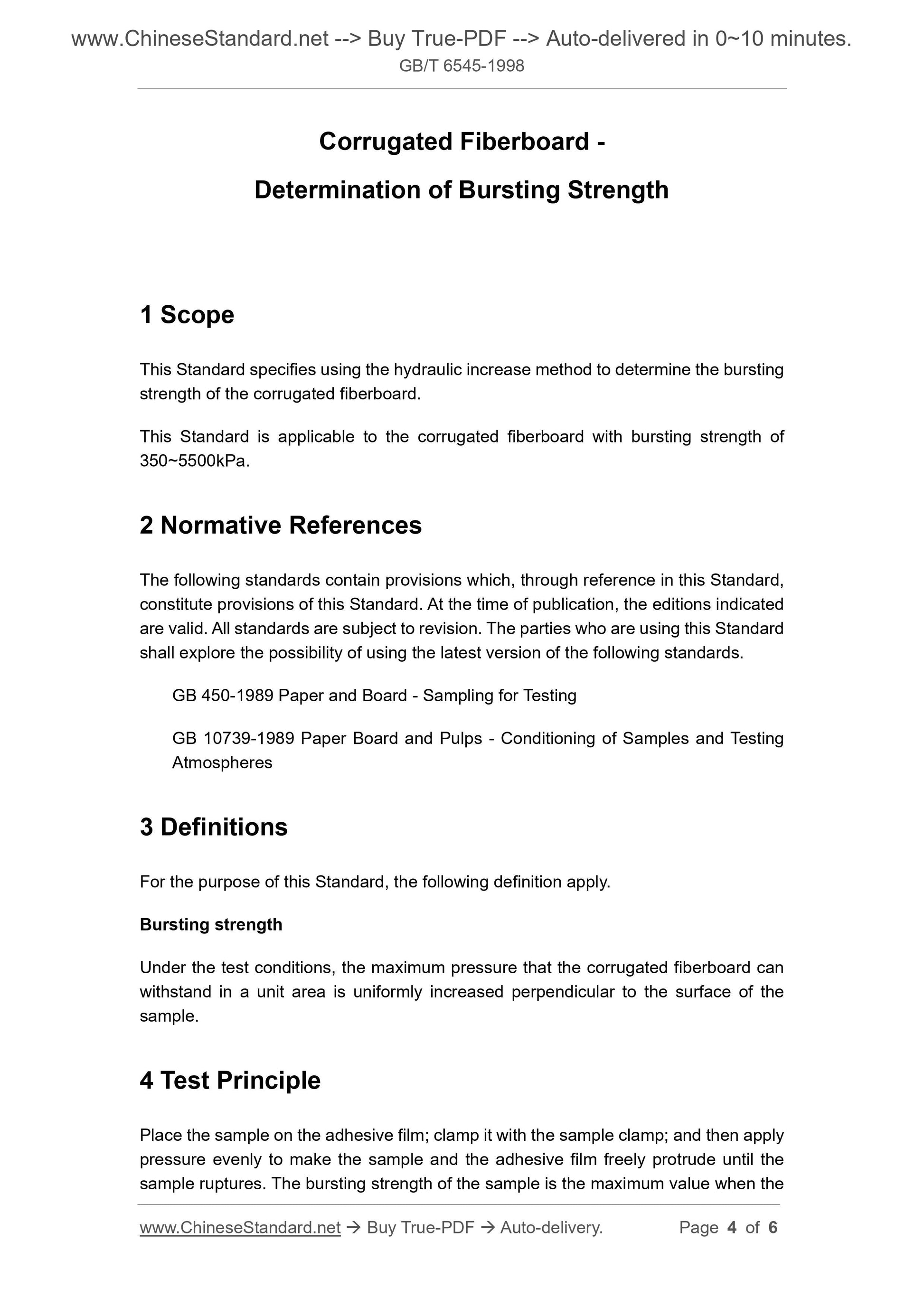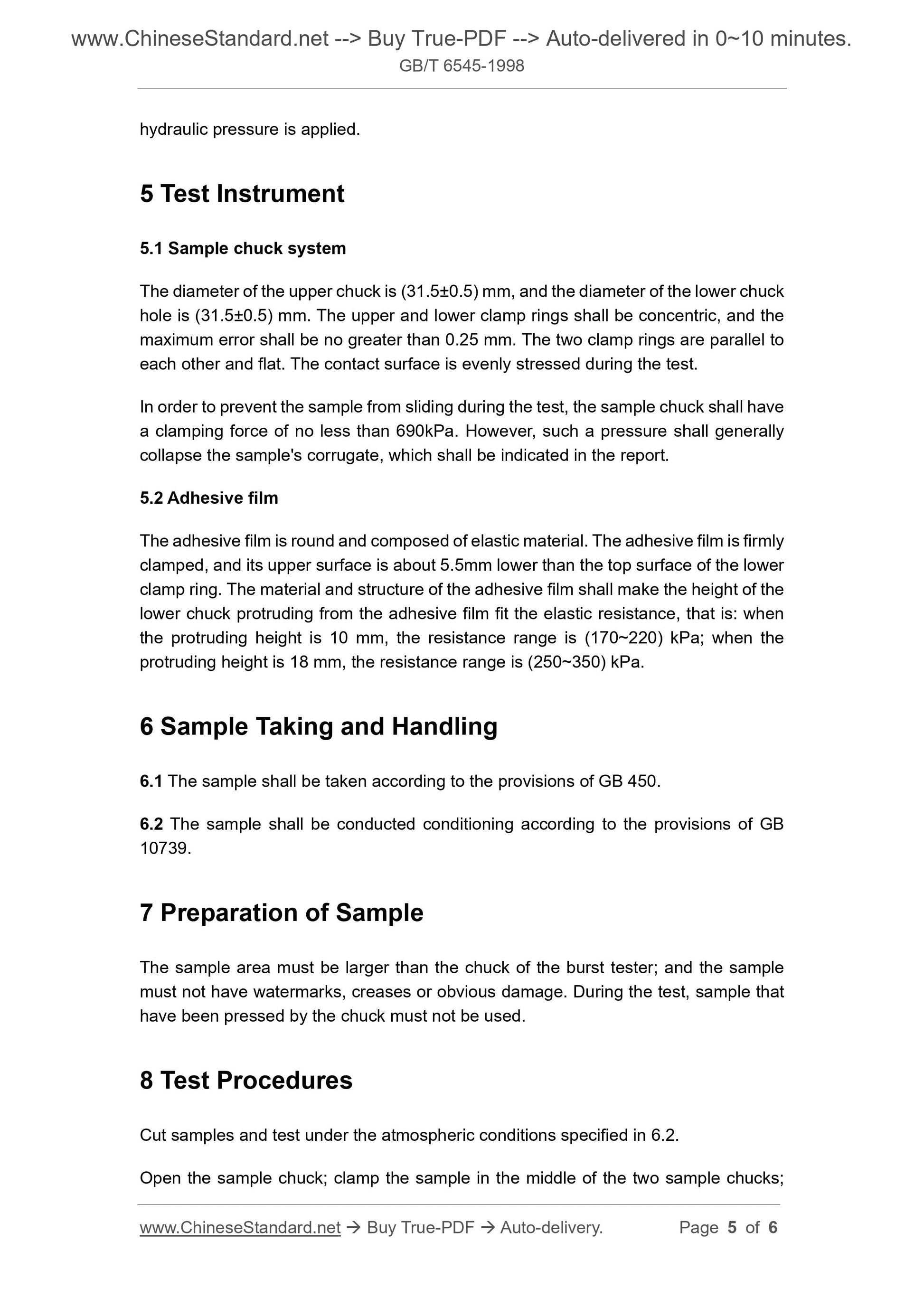1
/
of
4
www.ChineseStandard.us -- Field Test Asia Pte. Ltd.
GB/T 6545-1998 English PDF (GB/T6545-1998)
GB/T 6545-1998 English PDF (GB/T6545-1998)
Regular price
$100.00
Regular price
Sale price
$100.00
Unit price
/
per
Shipping calculated at checkout.
Couldn't load pickup availability
GB/T 6545-1998: Corrugated board. Determination of bursting strength
Delivery: 9 seconds. Download (& Email) true-PDF + Invoice.
Get Quotation: Click GB/T 6545-1998 (Self-service in 1-minute)
Historical versions (Master-website): GB/T 6545-1998
Preview True-PDF (Reload/Scroll-down if blank)
GB/T 6545-1998
NATIONAL STANDARD OF THE
PEOPLE’S REPUBLIC OF CHINA
ICS 85.080
Y 31
eqv ISO 2759:1983
Replacing GB 6545-1986
Corrugated Fiberboard -
Determination of Bursting Strength
ISSUED ON: MAY 19, 1998
IMPLEMENTED ON: FEBRUARY 01, 1999
Issued by: State Bureau of Quality and Technical Supervision
Table of Contents
Foreword ... 3
1 Scope ... 4
2 Normative References ... 4
3 Definitions ... 4
4 Test Principle ... 4
5 Test Instrument ... 5
6 Sample Taking and Handling ... 5
7 Preparation of Sample ... 5
8 Test Procedures ... 5
9 Result Expression ... 6
10 Test Report ... 6
Corrugated Fiberboard -
Determination of Bursting Strength
1 Scope
This Standard specifies using the hydraulic increase method to determine the bursting
strength of the corrugated fiberboard.
This Standard is applicable to the corrugated fiberboard with bursting strength of
350~5500kPa.
2 Normative References
The following standards contain provisions which, through reference in this Standard,
constitute provisions of this Standard. At the time of publication, the editions indicated
are valid. All standards are subject to revision. The parties who are using this Standard
shall explore the possibility of using the latest version of the following standards.
GB 450-1989 Paper and Board - Sampling for Testing
GB 10739-1989 Paper Board and Pulps - Conditioning of Samples and Testing
Atmospheres
3 Definitions
For the purpose of this Standard, the following definition apply.
Bursting strength
Under the test conditions, the maximum pressure that the corrugated fiberboard can
withstand in a unit area is uniformly increased perpendicular to the surface of the
sample.
4 Test Principle
Place the sample on the adhesive film; clamp it with the sample clamp; and then apply
pressure evenly to make the sample and the adhesive film freely protrude until the
sample ruptures. The bursting strength of the sample is the maximum value when the
hydraulic pressure is applied.
5 Test Instrument
5.1 Sample chuck system
The diameter of the upper chuck is (31.5±0.5) mm, and the diameter of the lower chuck
hole is (31.5±0.5) mm. The upper and lower clamp rings shall be concentric, and the
maximum error shall be no greater than 0.25 mm. The two clamp rings are parallel to
each other and flat. The contact surface is evenly stressed during the test.
In order to prevent the sample from sliding during the test, the sample chuck shall have
a clamping force of no less than 690kPa. However, such a pressure shall generally
collapse the sample's corrugate, which shall be indicated in the report.
5.2 Adhesive film
The adhesive film is round and composed of elastic material. The adhesive film is firmly
clamped, and its upper surface is about 5.5mm lower than the top surface of the lower
clamp ring. The material and structure of the adhesive film shall make the height of the
lower chuck protruding from the adhesive film fit the elastic resistance, that is: when
the protruding height is 10 mm, the resistance range is (170~220) kPa; when the
protruding height is 18 mm, the resistance range is (250~350) kPa.
6 Sample Taking and Handling
6.1 The sample shall be taken according to the provisions of GB 450.
6.2 The sample shall be conducted conditioning according to the provisions of GB
10739.
7 Preparation of Sample
The sample area must be larger than the chuck of the burst tester; and the sample
must not have watermarks, creases or obvious damage. During the test, sample that
have been pressed by the chuck must not be used.
8 Test Procedures
Cut samples and test under the atmospheric conditions specified in 6.2.
Open the sample chuck; clamp the sample in the middle of the two sample chucks;
GB/T 6545-1998
NATIONAL STANDARD OF THE
PEOPLE’S REPUBLIC OF CHINA
ICS 85.080
Y 31
eqv ISO 2759:1983
Replacing GB 6545-1986
Corrugated Fiberboard -
Determination of Bursting Strength
ISSUED ON: MAY 19, 1998
IMPLEMENTED ON: FEBRUARY 01, 1999
Issued by: State Bureau of Quality and Technical Supervision
Table of Contents
Foreword ... 3
1 Scope ... 4
2 Normative References ... 4
3 Definitions ... 4
4 Test Principle ... 4
5 Test Instrument ... 5
6 Sample Taking and Handling ... 5
7 Preparation of Sample ... 5
8 Test Procedures ... 5
9 Result Expression ... 6
10 Test Report ... 6
Corrugated Fiberboard -
Determination of Bursting Strength
1 Scope
This Standard specifies using the hydraulic increase method to determine the bursting
strength of the corrugated fiberboard.
This Standard is applicable to the corrugated fiberboard with bursting strength of
350~5500kPa.
2 Normative References
The following standards contain provisions which, through reference in this Standard,
constitute provisions of this Standard. At the time of publication, the editions indicated
are valid. All standards are subject to revision. The parties who are using this Standard
shall explore the possibility of using the latest version of the following standards.
GB 450-1989 Paper and Board - Sampling for Testing
GB 10739-1989 Paper Board and Pulps - Conditioning of Samples and Testing
Atmospheres
3 Definitions
For the purpose of this Standard, the following definition apply.
Bursting strength
Under the test conditions, the maximum pressure that the corrugated fiberboard can
withstand in a unit area is uniformly increased perpendicular to the surface of the
sample.
4 Test Principle
Place the sample on the adhesive film; clamp it with the sample clamp; and then apply
pressure evenly to make the sample and the adhesive film freely protrude until the
sample ruptures. The bursting strength of the sample is the maximum value when the
hydraulic pressure is applied.
5 Test Instrument
5.1 Sample chuck system
The diameter of the upper chuck is (31.5±0.5) mm, and the diameter of the lower chuck
hole is (31.5±0.5) mm. The upper and lower clamp rings shall be concentric, and the
maximum error shall be no greater than 0.25 mm. The two clamp rings are parallel to
each other and flat. The contact surface is evenly stressed during the test.
In order to prevent the sample from sliding during the test, the sample chuck shall have
a clamping force of no less than 690kPa. However, such a pressure shall generally
collapse the sample's corrugate, which shall be indicated in the report.
5.2 Adhesive film
The adhesive film is round and composed of elastic material. The adhesive film is firmly
clamped, and its upper surface is about 5.5mm lower than the top surface of the lower
clamp ring. The material and structure of the adhesive film shall make the height of the
lower chuck protruding from the adhesive film fit the elastic resistance, that is: when
the protruding height is 10 mm, the resistance range is (170~220) kPa; when the
protruding height is 18 mm, the resistance range is (250~350) kPa.
6 Sample Taking and Handling
6.1 The sample shall be taken according to the provisions of GB 450.
6.2 The sample shall be conducted conditioning according to the provisions of GB
10739.
7 Preparation of Sample
The sample area must be larger than the chuck of the burst tester; and the sample
must not have watermarks, creases or obvious damage. During the test, sample that
have been pressed by the chuck must not be used.
8 Test Procedures
Cut samples and test under the atmospheric conditions specified in 6.2.
Open the sample chuck; clamp the sample in the middle of the two sample chucks;
Delivery: 9 seconds. Download (& Email) true-PDF + Invoice.
Get Quotation: Click GB/T 6545-1998 (Self-service in 1-minute)
Historical versions (Master-website): GB/T 6545-1998
Preview True-PDF (Reload/Scroll-down if blank)
GB/T 6545-1998
NATIONAL STANDARD OF THE
PEOPLE’S REPUBLIC OF CHINA
ICS 85.080
Y 31
eqv ISO 2759:1983
Replacing GB 6545-1986
Corrugated Fiberboard -
Determination of Bursting Strength
ISSUED ON: MAY 19, 1998
IMPLEMENTED ON: FEBRUARY 01, 1999
Issued by: State Bureau of Quality and Technical Supervision
Table of Contents
Foreword ... 3
1 Scope ... 4
2 Normative References ... 4
3 Definitions ... 4
4 Test Principle ... 4
5 Test Instrument ... 5
6 Sample Taking and Handling ... 5
7 Preparation of Sample ... 5
8 Test Procedures ... 5
9 Result Expression ... 6
10 Test Report ... 6
Corrugated Fiberboard -
Determination of Bursting Strength
1 Scope
This Standard specifies using the hydraulic increase method to determine the bursting
strength of the corrugated fiberboard.
This Standard is applicable to the corrugated fiberboard with bursting strength of
350~5500kPa.
2 Normative References
The following standards contain provisions which, through reference in this Standard,
constitute provisions of this Standard. At the time of publication, the editions indicated
are valid. All standards are subject to revision. The parties who are using this Standard
shall explore the possibility of using the latest version of the following standards.
GB 450-1989 Paper and Board - Sampling for Testing
GB 10739-1989 Paper Board and Pulps - Conditioning of Samples and Testing
Atmospheres
3 Definitions
For the purpose of this Standard, the following definition apply.
Bursting strength
Under the test conditions, the maximum pressure that the corrugated fiberboard can
withstand in a unit area is uniformly increased perpendicular to the surface of the
sample.
4 Test Principle
Place the sample on the adhesive film; clamp it with the sample clamp; and then apply
pressure evenly to make the sample and the adhesive film freely protrude until the
sample ruptures. The bursting strength of the sample is the maximum value when the
hydraulic pressure is applied.
5 Test Instrument
5.1 Sample chuck system
The diameter of the upper chuck is (31.5±0.5) mm, and the diameter of the lower chuck
hole is (31.5±0.5) mm. The upper and lower clamp rings shall be concentric, and the
maximum error shall be no greater than 0.25 mm. The two clamp rings are parallel to
each other and flat. The contact surface is evenly stressed during the test.
In order to prevent the sample from sliding during the test, the sample chuck shall have
a clamping force of no less than 690kPa. However, such a pressure shall generally
collapse the sample's corrugate, which shall be indicated in the report.
5.2 Adhesive film
The adhesive film is round and composed of elastic material. The adhesive film is firmly
clamped, and its upper surface is about 5.5mm lower than the top surface of the lower
clamp ring. The material and structure of the adhesive film shall make the height of the
lower chuck protruding from the adhesive film fit the elastic resistance, that is: when
the protruding height is 10 mm, the resistance range is (170~220) kPa; when the
protruding height is 18 mm, the resistance range is (250~350) kPa.
6 Sample Taking and Handling
6.1 The sample shall be taken according to the provisions of GB 450.
6.2 The sample shall be conducted conditioning according to the provisions of GB
10739.
7 Preparation of Sample
The sample area must be larger than the chuck of the burst tester; and the sample
must not have watermarks, creases or obvious damage. During the test, sample that
have been pressed by the chuck must not be used.
8 Test Procedures
Cut samples and test under the atmospheric conditions specified in 6.2.
Open the sample chuck; clamp the sample in the middle of the two sample chucks;
GB/T 6545-1998
NATIONAL STANDARD OF THE
PEOPLE’S REPUBLIC OF CHINA
ICS 85.080
Y 31
eqv ISO 2759:1983
Replacing GB 6545-1986
Corrugated Fiberboard -
Determination of Bursting Strength
ISSUED ON: MAY 19, 1998
IMPLEMENTED ON: FEBRUARY 01, 1999
Issued by: State Bureau of Quality and Technical Supervision
Table of Contents
Foreword ... 3
1 Scope ... 4
2 Normative References ... 4
3 Definitions ... 4
4 Test Principle ... 4
5 Test Instrument ... 5
6 Sample Taking and Handling ... 5
7 Preparation of Sample ... 5
8 Test Procedures ... 5
9 Result Expression ... 6
10 Test Report ... 6
Corrugated Fiberboard -
Determination of Bursting Strength
1 Scope
This Standard specifies using the hydraulic increase method to determine the bursting
strength of the corrugated fiberboard.
This Standard is applicable to the corrugated fiberboard with bursting strength of
350~5500kPa.
2 Normative References
The following standards contain provisions which, through reference in this Standard,
constitute provisions of this Standard. At the time of publication, the editions indicated
are valid. All standards are subject to revision. The parties who are using this Standard
shall explore the possibility of using the latest version of the following standards.
GB 450-1989 Paper and Board - Sampling for Testing
GB 10739-1989 Paper Board and Pulps - Conditioning of Samples and Testing
Atmospheres
3 Definitions
For the purpose of this Standard, the following definition apply.
Bursting strength
Under the test conditions, the maximum pressure that the corrugated fiberboard can
withstand in a unit area is uniformly increased perpendicular to the surface of the
sample.
4 Test Principle
Place the sample on the adhesive film; clamp it with the sample clamp; and then apply
pressure evenly to make the sample and the adhesive film freely protrude until the
sample ruptures. The bursting strength of the sample is the maximum value when the
hydraulic pressure is applied.
5 Test Instrument
5.1 Sample chuck system
The diameter of the upper chuck is (31.5±0.5) mm, and the diameter of the lower chuck
hole is (31.5±0.5) mm. The upper and lower clamp rings shall be concentric, and the
maximum error shall be no greater than 0.25 mm. The two clamp rings are parallel to
each other and flat. The contact surface is evenly stressed during the test.
In order to prevent the sample from sliding during the test, the sample chuck shall have
a clamping force of no less than 690kPa. However, such a pressure shall generally
collapse the sample's corrugate, which shall be indicated in the report.
5.2 Adhesive film
The adhesive film is round and composed of elastic material. The adhesive film is firmly
clamped, and its upper surface is about 5.5mm lower than the top surface of the lower
clamp ring. The material and structure of the adhesive film shall make the height of the
lower chuck protruding from the adhesive film fit the elastic resistance, that is: when
the protruding height is 10 mm, the resistance range is (170~220) kPa; when the
protruding height is 18 mm, the resistance range is (250~350) kPa.
6 Sample Taking and Handling
6.1 The sample shall be taken according to the provisions of GB 450.
6.2 The sample shall be conducted conditioning according to the provisions of GB
10739.
7 Preparation of Sample
The sample area must be larger than the chuck of the burst tester; and the sample
must not have watermarks, creases or obvious damage. During the test, sample that
have been pressed by the chuck must not be used.
8 Test Procedures
Cut samples and test under the atmospheric conditions specified in 6.2.
Open the sample chuck; clamp the sample in the middle of the two sample chucks;
Share
